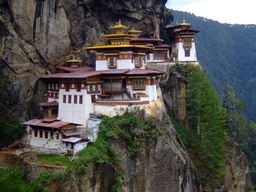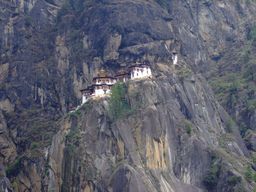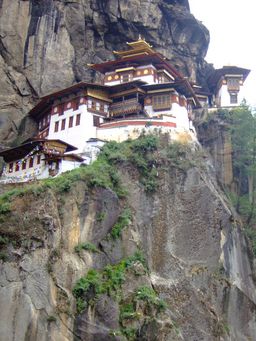Paro Taktsang
Paro Taktsang (spa phro stag tshang) / (spa gro stag tshang) / (spa gro stag tshang bsam grub ke'u tshang)
One of the thirteen taktsang, or "Tiger Lair", sacred caves in Tibet and Bhutan blessed by Guru Padmasambhava and the seventh of the eight sacred places in Tibet and Bhutan he blessed for the practice of the Eight Classes of Herukas (sgrub pa bka' brgyad). In particular this is the place related to Jigten Chöto ('jigs rten mchod bstod), where Langchen Palseng (rlangs chen dpal seng), attained realization.
- spa gro stag tshang - Padro Tagtshang which is a meditation place in Bhutan [JV]
- spa gro stag tshang bsam grub ke'u tshang - Paro Taktsang, in Bhutan [RY]
Visit of Padmasambhava[edit]
In the 8th Century CE Guru Rinpoche visited Bhutan and blessed it as the second Kailash. At that time malignant spirits abounded and, in order to subdue them, he assumed the terrifying form of Guru Dorje Dröllo one of the Eight Manifistations of Guru Rinpoche (gu ru mtshan brgyad) and consecrated Paro Taksang as a sacred site to protect the Dharma and subdue harmful forces.
According to the Namthar Yid kyi Munsel (གུ་རུའི་རྣམ་ཐར་ཡིད་ཀྱི་མུན་སེལ) Padmasambhava spent four months meditating in a cave at Taktsang taming and subjugating the eight classes of malicious spirits. He concealed many profound treasures at Taktsang.
Visit of Langchen Palgyi Senge[edit]
While confering the empowerments of the Eight Classes of Herukas Cycle to the Twenty-five Disciples at Yamalung, Guru Rinpoche instructed Langchen Palgyi Senge (rlangs chen dpal gyi seng ge) to carry out the practice of the Fierce Mantra of the Tamer of All Haughty Spirits at Taksang Senge Samdup in the Paro valley of Bhutan.
In accordance with these instructions Langchen Palgyi Senge came to Paro Taksang in 853 CE meditating until he accomplished the practice of the "Tamer of All Haughty Spirits" gaining profound siddhi which enabled him to bind gods and spirits to his service.
The cave in which he meditated became known as Pelphug or Drubphug.
Visit of Padampa Sangye[edit]
Visit of Phajo Drukgom Zhigpo[edit]
Phajo Drukgom Zhigpo (1184-1251) who originally established the Middle Drukpa Kagyu school in Bhutan meditated for a time at Taktsang. In a clear vision he was instructed by Guru Rinpoche to meditate at twelve places in Bhutan: four dzongs, four crags and four caves.
Visit of Thangtong Gyalpo[edit]
Thangtong Gyalpo meditated at Taktsang and discovered the terma of Mengak Domchu (མན་ངག་འདོམ་བཅུ་མ) in the cave of Sengge Phug
The nine sacred caves at Paro Taksang[edit]
- Machig Phug (ma gcig phug) - the cave where Machik Labdron meditated.
- Senge Phug (seng ge phug)- the cave where Guru Rinpoche meditated on Vajra Kilaya.
- Pelphug (dpal phug) - the cave where Guru Rinpoche meditated for four months on phur pa'i lha tshogs and
- Drolo Phug (gro lod phug)
- Osel Phug ('od gsal phug)
- Gedig Phug (dge sdig phug)
- Chogyal Phug (chos rgyal phug)
- Kapali Phug (ka pa li phug)
- Phagmo Phug (phag mo phug)
Lhakhang[edit]
There are seven chapels within the present temple complex:
- Drubkhang (sgrub khang)
- Chapel of the Speaking Guru (gu ru gsung byon ma'i lha khang)
- Dröllo Lhakhang (gro lod lha khang)
- Chapel of Amitayus (rtse dpag med lha khang)
- Chapel of Vaishravana (rnam sras lha khang)
- Shrine room of Nedag Senge Samdup (seng ge bsam grub gnas khang)
- Chapel of Marpa, Milarepa and Gampopa (mar mi dvags sum lha khang)
The key to the sacred site of Taktsang is at Shama Lhakhang (gsha' ma lha khang). Although Shama is very close to Taksang one must ascend to Urgyen Tsemo at the top of the cliff and then descend through a small ravine to reach Shama.
Consruction of Temple[edit]
The first known temple at Taksang Pelphug was built in about c. 1508 by Sonam Gyaltsen a Nyingma lama belonging to the Kathog lineage who was invited from Tibet by Taksang Lama Nganggyu (ngang rgyud). Lama Sonam Gyaltsen resided at nearby Urgyen Tsemo temple above Taksang, which had been established by his uncle Yeshi Bunpa (). Sonam Gyaltsen transmitted the whole Nyingma Gyubum to his disciples. The shrine of Taksang remained in the care of his family lineage until the 17th Century.
In 1645 Shabdrung Ngawang Namgyal visited Taktsang with his Nyingma teacher Rigdzin Nyingpo, a descendant of Terton Sangye Lingpa, and at that time the temple was offered to him.
Construction of a large Lhakhang at Taksang Pelphug was begun by Shabdrung Rinpoche's successor Gyalse Tenzin Rabgye in 1692. The construction was supervised by the artisan Grags-pa rGya-mtsho. Sacred images were made by the Newar artists Pañca Deva, Darma Deva and Darma Shrī. Gyalse Tenzin Rabgye also commissioned the construction of Shama Lhakhang.
Fires and Restoration[edit]
Alternate Names & Spellings[edit]
- Padro Taktsang (spa gro stag tshang)
- Paro Taktsang (spa phro stag tshang)
- Paro Taksang, Paro Taktshang
- Taksang Senge Samdup (stag tshang seng ge bsam grub)
- Taksang Pelphug
- spa gro stag tshang bsam grub ke'u tshang
Pilgrimage to Paro Taktsang[edit]
Those who wish to go on pilgrimage to Paro Taktsang and nearby sacred sites, should obtain a special permit from the Department of Culture, Ministry of Home & Cultural Affairs, Thimphu. In order to maintain the sanctity of the place, ordinary tourists without a permit are not usually allowed beyond Tsogyal Pangchung (meadow of Yeshe Tsogyal) before the Shelkarchu waterfall. At that place there is however an excellent view of Taktsang and a place to offer butterlamps.
The complete pilgrimage to Taktsang consists of an outer (), middle () and inner() pilgrimage:
Outer pilgrimage
- Dumtseg Lhakhang (bzlums brtsegs lha khang)
- Kunga Choling
- Sangngak Chokhor
- Ribur Gonpa
- Chochongtse
- Bumdrag (bum 'brag)
Middle pilgrimage
- Kyerchu Temple (skyer chu'i lha khang)
- Ramthangkha
- Lhundrup Choling
- Zangdopelri
- Oselgang
- Shama
Inner Pilgrimage
- Machig Phug (ma gcig phug)
- Senge Phug
- Langchen Kudung Lhakhang
- Drölo Lhakhang (gro lod lha khang)
- Chapel of Namsey, Chapel of Amitayus , Shrine of Nedag Senge Samdup, Chapel of Marpa, Milarepa and Gampopa.
- Sungjongmai Lhakhang
- Pelphug Drubkhang
References[edit]
- John A. Ardussi: Gyalse Tenzin Rabgye and the Founding of Taktsang Lhakhang. Journal of Bhutan Studies, 1:1, 1999
- Guide to Taktshang (གནས་ཆེན་སྟག་ཚང་ལམ་འཁྲིད)/ Restored Taktshang (ཉམས་གསོ་ཞུགས་པའི་སྟག་ཚང་), Department of Culture, Thimphu, Bhutan 2005. ISBN 9993661716


